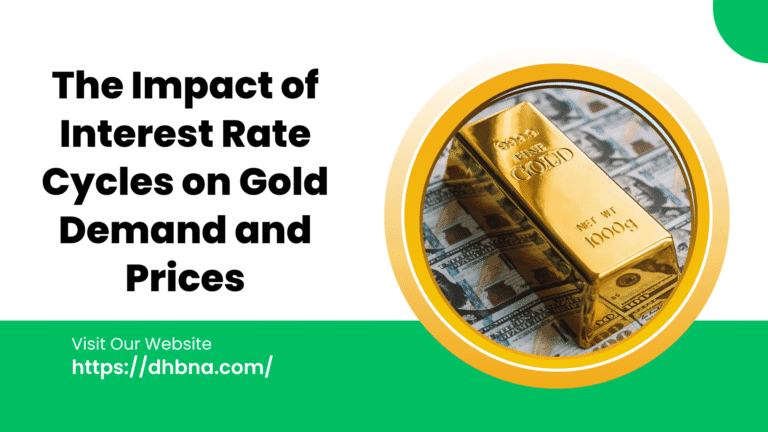The relationship between interest rate cycles and gold demand and prices is a cornerstone of modern financial analysis. As central banks adjust policy rates to tame inflation or stimulate economic growth, investors often turn to gold as a safe haven or hedge. This comprehensive article explores how rising and falling interest rate cycles influence gold’s appeal, shape its price trajectory, and drive demand across different investor segments. Whether you’re a macro strategist, a bullion trader, or a long-term saver, understanding these dynamics is crucial for optimizing your gold allocation and timing.
Understanding Interest Rate Cycles
What Are Interest Rate Cycles?
Interest rate cycles refer to the systematic movements in central bank policy rates over time. Typically, these cycles consist of four phases:
- Accommodative (Easing) Phase: Rates are cut to stimulate growth.
- Expansion Phase: Economic activity picks up; rates stabilize at low levels.
- Tightening Phase: Rates are raised to curb inflation.
- Contraction Phase: Economic slowdown prompts rate cuts, restarting the cycle.
Drivers of Rate Decisions
Central banks, such as the Federal Reserve, ECB, or Bank of Japan, calibrate rates based on:
- Inflation Trends: Targeting optimal price stability.
- Labor Market Conditions: Balancing unemployment with wage growth.
- Economic Growth Indicators: GDP, consumer spending, business investment.
- Global Financial Stability: Responding to cross-border capital flows.
Theoretical Linkages: Interest Rates and Gold Prices
Opportunity Cost of Holding Gold
Gold offers no yield. When interest rates rise, alternative assets like bonds offer higher returns, increasing the opportunity cost of holding gold. Conversely, when rates fall, gold’s opportunity cost diminishes, enhancing its attractiveness.
Real Interest Rates and Inflation
Real interest rates (nominal rates minus inflation) are critical. Negative real rates, often in easing cycles, make gold appealing as an inflation hedge. Positive real rates in tightening cycles can reduce gold demand.
Currency Dynamics
Interest rate differentials influence currency values. Higher domestic rates can strengthen the currency, making dollar-denominated gold more expensive for foreign buyers, potentially dampening demand.
Historical Evidence: Rate Cycles vs. Gold Performance
2000–2008: Pre-Financial Crisis Easing
During the early 2000s, the Fed slashed rates from 6.5% to 1% to combat recession. Gold soared from $250 to $1,000 by 2008, reflecting low real rates and rising inflationary fears.
2008–2015: Post-Crisis Accommodation
Following the 2008 crisis, unprecedented quantitative easing and near-zero rates fueled gold’s 2011 peak near $1,900. Despite subsequent tapering, real rates remained depressed, supporting elevated gold prices.
2015–2019: Gradual Tightening
The Fed’s gradual tightening from 2015 to 2018 saw gold dip to $1,150 by late 2015 before modest recovery. Rising real rates pressured gold but safe-haven demand limited downside.
2020–2022: Pandemic Shock and Re-Easing
In response to COVID-19, rates collapsed to zero worldwide. Gold briefly hit an all-time high above $2,050 in August 2020. Renewed inflation and later tightening cycles have since weighed on gold but volatility remains high.
Mechanisms in Different Market Environments
During Tightening Cycles
- Higher Yields Attract Capital: Bond yields compete with gold, prompting portfolio shifts.
- Stronger Currency Effect: Rate hikes boost the dollar, pushing gold prices down in local currencies.
- Inflation Containment: Successful rate hikes tame inflation expectations, reducing gold’s inflation-hedge appeal.
During Easing Cycles
- Lower Yields Support Gold: Fixed-income yields plummet, making gold relatively more attractive.
- Currency Depreciation: Rate cuts can weaken the currency, spurring gold buying as a store of value.
- Quantitative Easing (QE): Large-scale asset purchases by central banks often coincide with gold rallies.
Gold Demand Across Investor Segments
Central Banks
Central banks diversify reserves and reduce currency risk by buying gold, especially when policy rates are low and currencies vulnerable.
Retail Investors
Retail gold purchases via ETFs and physical coins often spike when interest rates fall or inflation fears rise.
Institutional Investors
Pension funds and insurance companies incorporate gold to hedge long-duration liabilities, particularly in negative real rate environments.
Jewelry and Industrial Demand
While driven more by income and cultural factors, jewelry demand can also respond to rate cycles indirectly through consumer confidence and inflation expectations.
Case Studies: Central Bank Buying Patterns
India and China
In recent easing cycles, India and China have been notable gold buyers, using purchases to diversify away from the U.S. dollar and hedge domestic currency risks.
Emerging Market Central Banks
Countries like Turkey and Russia have ramped up gold reserves when domestic rates were high but real yields turned negative, signaling distrust in fiat currencies.
Quantitative Analysis: Correlation and Regression Studies
Several academic and industry studies quantify the gold–rate relationship:
- Correlation Analysis: Real interest rates inversely correlate with gold returns, often between -0.4 and -0.6.
- Regression Models: Multi-factor models incorporating real rates, inflation, and currency indices explain 60–80% of gold price movements over medium term.
Strategies for Gold Investors

Tactical Allocation Based on Rate Outlook
- Pre‑Tightening: Reduce gold exposure as rate cuts moderate.
- Pre‑Easing: Increase gold allocation ahead of expected rate cuts or QE.
Hedging with Gold Futures and Options
- Use Section 1256 futures contracts to capture gains in easing environments with favorable 60/40 tax treatment.
- Purchase options as insurance against unexpected rate cuts or surging inflation.
Geographic Diversification
- Hold gold in multiple currencies or vaults to offset country-specific rate and currency risks.
Risks and Caveats
- Timing Uncertainty: Predicting rate cycle turns is notoriously difficult.
- Other Drivers: Supply shocks, geopolitical crises, and market sentiment can override rate effects.
- Liquidity Considerations: Physical gold can have higher transaction costs than financial instruments.
Conclusion
Interest rate cycles have a profound impact on gold demand and prices, influencing opportunity costs, real yields, and currency dynamics. Historical evidence underscores gold’s strength in easing phases and vulnerability in tightening regimes—though other factors also play significant roles. By understanding these mechanisms and adopting strategic allocation, hedging, and diversification techniques, investors can better leverage gold’s unique attributes across the rate cycle spectrum.
Effective gold portfolio management hinges on continuously monitoring central bank signals, economic indicators, and global risk landscapes to anticipate shifts in gold demand and pricing. This nuanced approach helps ensure that gold remains a robust component of a diversified, resilient investment strategy in any interest rate environment.



